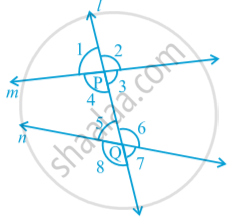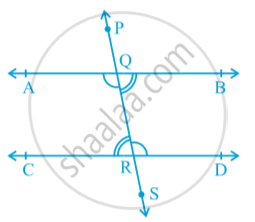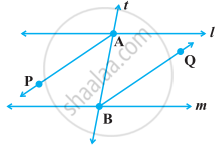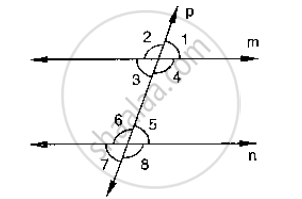Topics
Number Systems
Number Systems
Polynomials
Algebra
Coordinate Geometry
Linear Equations in Two Variables
Geometry
Coordinate Geometry
Introduction to Euclid’S Geometry
Mensuration
Statistics and Probability
Lines and Angles
- Introduction to Lines and Angles
- Basic Terms and Definitions
- Intersecting Lines and Non-intersecting Lines
- Introduction to Parallel Lines
- Pairs of Angles
- Parallel Lines and a Transversal
- Angle Sum Property of a Triangle
Triangles
- Concept of Triangles
- Congruence of Triangles
- Criteria for Congruence of Triangles
- Properties of a Triangle
- Some More Criteria for Congruence of Triangles
- Inequalities in a Triangle
Quadrilaterals
- Concept of Quadrilaterals
- Properties of a Quadrilateral
- Types of Quadrilaterals
- Another Condition for a Quadrilateral to Be a Parallelogram
- Theorem of Midpoints of Two Sides of a Triangle
- Property: The Opposite Sides of a Parallelogram Are of Equal Length.
- Theorem: A Diagonal of a Parallelogram Divides It into Two Congruent Triangles.
- Theorem : If Each Pair of Opposite Sides of a Quadrilateral is Equal, Then It is a Parallelogram.
- Property: The Opposite Angles of a Parallelogram Are of Equal Measure.
- Theorem: If in a Quadrilateral, Each Pair of Opposite Angles is Equal, Then It is a Parallelogram.
- Property: The diagonals of a parallelogram bisect each other. (at the point of their intersection)
- Theorem : If the Diagonals of a Quadrilateral Bisect Each Other, Then It is a Parallelogram
Circles
Areas - Heron’S Formula
Surface Areas and Volumes
Statistics
Algebraic Expressions
Algebraic Identities
Area
Constructions
- Introduction of Constructions
- Basic Constructions
- Some Constructions of Triangles
Probability
Notes
A line which intersects two or more lines at distinct points is called a transversal in following fig .
Line l intersects lines m and n at points P and Q respectively. Therefore, line l is a transversal for lines m and n. Observe that four angles are formed at each of the points P and Q. Let us name these angles as ∠ 1, ∠ 2, . . ., ∠8 as shown in above Fig.
∠ 1, ∠ 2, ∠ 7 and ∠ 8 are called exterior angles, while ∠ 3, ∠ 4, ∠ 5 and ∠ 6 are called interior angles.
Some pairs of angles formed when a transversal intersects two lines. These are as follows:
(a) Corresponding angles :
(i) ∠ 1 and ∠ 5 (ii) ∠ 2 and ∠ 6
(iii) ∠ 4 and ∠ 8 (iv) ∠ 3 and ∠ 7
(b) Alternate interior angles :
(i) ∠ 4 and ∠ 6 (ii) ∠ 3 and ∠ 5
(c) Alternate exterior angles:
(i) ∠ 1 and ∠ 7 (ii) ∠ 2 and ∠ 8
(d) Interior angles on the same side of the transversal:
(i) ∠ 4 and ∠ 5 (ii) ∠ 3 and ∠ 6
Interior angles on the same side of the transversal are also referred to as consecutive interior angles or allied angles or co-interior angles.
Text
Axiom: If a transversal intersects two parallel lines, then each pair of corresponding angles is equal.
Axiom is also referred to as the corresponding angles axiom.
If a transversal intersects two lines such that a pair of corresponding angles is equal, then the two lines are parallel.
It can be verified as follows: Draw a line AD and mark points B and C on it. At B and C, construct ∠ ABQ and ∠ BCS equal to each other as shown in Fig.
Produce QB and SC on the other side of AD to form two lines PQ and RS . You may observe that the two lines do not intersect each other. You may also draw common perpendiculars to the two lines PQ and RS at different points and measure their lengths. Therefore, the converse of corresponding angles axiom is also true.
Axiom: If a transversal intersects two lines such that a pair of corresponding angles is equal, then the two lines are parallel to each other.
The relation between the alternate interior angles when a transversal intersects two parallel lines ? in fig.

transveral PS intersects parallel lines AB and CD at points Q and R respectively.
Is ∠ BQR = ∠ QRC and ∠ AQR = ∠ QRD?
You know that ∠ PQA = ∠ QRC (1) (Corresponding angles axiom)
Is ∠ PQA = ∠ BQR (2)
So, from (1) and (2), you may conclude that
∠ BQR = ∠ QRC.
Similarly, ∠ AQR = ∠ QRD.
Theorem
Theorem: If a transversal intersects two parallel lines, then each pair of alternate interior angles is equal.

In above fig. the transversal PS intersects lines AB and CD at points Q and R respectively such that ∠ BQR = ∠ QRC.
Is AB || CD
∠ BQR = ∠ PQA (1)
But, ∠ BQR = ∠ QRC (Given) (2)
So, from (1) and (2), you may conclude that
∠ PQA = ∠ QRC
But they are corresponding angles.
So, AB || CD (Converse of corresponding angles axiom)
Theorem: If a transversal intersects two lines such that a pair of alternate interior angles is equal, then the two lines are parallel.
Theorem: If a transversal intersects two parallel lines, then each pair of interior angles on the same side of the transversal is supplementary.
Theorem: If a transversal intersects two lines such that a pair of interior angles on the same side of the transversal is supplementary, then the two lines are parallel.
Shaalaa.com | Parallel lines and Transversal
Series:
00:31:58 undefined
00:13:41 undefined
00:10:55 undefined
00:12:44 undefined
00:12:59 undefined






